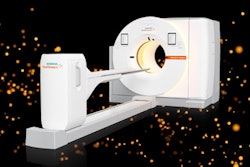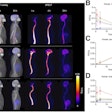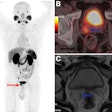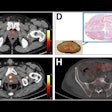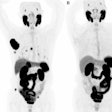Receiving results from amyloid beta testing as a possible precursor of Alzheimer’s disease did not have a significant negative emotional impact on patients, regardless of whether the results were positive or negative, findings from a new study show.
However, receiving the results decreased the motivation to make lifestyle changes associated with lowered risk for Alzheimer’s disease whether the results were positive or negative, according to the study published in the May issue of Alzheimer’s & Dementia.
As a biomarker for Alzheimer’s disease, beta amyloid has been found to be reliable to the extent that testing is sufficient for diagnosis. Furthermore, beta amyloid can be detected years before Alzheimer’s disease symptom onset in patients either via cerebrospinal fluid or blood testing or using PET brain imaging.
Orit H. Lesman-Segev, MD, from the Joseph Sagol Neuroscience Center at Sheba Medical Center in Ramat Gan, Israel, and colleagues from medical centers in both Israel and the U.S. sought to establish the emotional responses of cognitively normal patients on disclosure of their beta-amyloid test results, as well as on follow-up.
The researchers recruited cognitively normal adults who were at risk for Alzheimer’s disease and related dementia from two observational studies and two interventional trials that incorporated beta-amyloid PET scans. The participants were given a questionnaire that covered four areas: anxiety about the scan results showing elevated beta-amyloid levels; depression, also related to possible elevated beta-amyloid levels; subjective memory complaints (SMCs), i.e., any experience of memory decline; and level of motivation to make lifestyle changes that might mitigate risk (e.g., diet and exercise). The questions were asked both before and six months after the disclosure of results from beta-amyloid testing.
The authors noted that disclosure of the PET results “was performed verbally in a structured phone call followed by a letter sent to the participant through the mail.”
Of the study participants, 21 (10.6%) had PET scans indicating elevated beta-amyloid levels. These participants were older on average than other participants, the authors said (median 62.5 years [55.4–71] vs. median 80.8 years [72.9–82.5]; p < 0.001). In the responses submitted before testing, these participants showed no differences from other participants regarding anxiety, SMCs, or lifestyle changes; however, they had a decreased level of depression regarding the possibility of positive results from those with negative beta-amyloid results.
In questionnaire responses following the disclosure of test results, those who received negative results generally showed a favorable response, with statistically significant decreases in SMCs, depression, and anxiety. However, they also showed a decrease in their reported motivation to make risk-mitigating lifestyle changes.
The participants who received the elevated beta-amyloid status results evinced no change in their responses in follow-up responses concerning SMCs or depression related to possible elevated beta-amyloid levels. However, their anxiety related to the possibility of a positive result went down, as did their motivation to adopt lifestyle changes (although not as much as those who had received negative results).
 Motivation to change lifestyle before and after the disclosure of a non-elevated or an elevated Aβ result. A colored line connects each subject’s motivation to change lifestyle score (1–lowest motivation, 5–highest motivation) before and after disclosure. The color indicates whether there has been a decrease (green), increase (red), or no change (yellow) in the response. The black arrow represents the within-group comparison between the pre- and post-PET responses (Wilcoxon signed-rank test), while the absolute within-group change in score after disclosure is presented beneath it (value, SD). The dashed arrow represents the between-group comparison of the change in response between the non-elevated (A) versus the elevated (B) Aβ groups (mixed effects models; p value of the timepoint x result is presented). Bar plots describe the group-level change in motivation to change lifestyle scores after the disclosure of a non-elevated Aβ result (A’) or an elevated Aβ result (B’). P value. *p < 0.05, *p < 0.01, ***p < 0.001. Aβ, amyloid beta; PET, positron emission tomography; SD, standard deviation.Courtesy Lesman-Segev et al., Alzheimer's & Dementia
Motivation to change lifestyle before and after the disclosure of a non-elevated or an elevated Aβ result. A colored line connects each subject’s motivation to change lifestyle score (1–lowest motivation, 5–highest motivation) before and after disclosure. The color indicates whether there has been a decrease (green), increase (red), or no change (yellow) in the response. The black arrow represents the within-group comparison between the pre- and post-PET responses (Wilcoxon signed-rank test), while the absolute within-group change in score after disclosure is presented beneath it (value, SD). The dashed arrow represents the between-group comparison of the change in response between the non-elevated (A) versus the elevated (B) Aβ groups (mixed effects models; p value of the timepoint x result is presented). Bar plots describe the group-level change in motivation to change lifestyle scores after the disclosure of a non-elevated Aβ result (A’) or an elevated Aβ result (B’). P value. *p < 0.05, *p < 0.01, ***p < 0.001. Aβ, amyloid beta; PET, positron emission tomography; SD, standard deviation.Courtesy Lesman-Segev et al., Alzheimer's & Dementia
The authors added that participants with lower education levels were more likely to report an increase in SMCs, and those who were in one of the two interventional trials were more likely to report an increase in anxiety in the follow-up questionnaire, despite having received negative results.
While the researchers could provide no definitive reasoning behind the decreased motivation to make lifestyle changes for either group following the receipt of test results, they suggest that for those who do not have elevated beta-amyloid levels, it may be attributable to a false sense of reassurance and relief. No demographic or clinical factors were found to be correlated with the decline for either group, and they could not find a possible explanation for the smaller decrease in those with positive results. The change, they suggest, shows a need for greater emphasis on the need for these changes.
The study group does note that while their cohort was relatively large, the number of participants with positive results was small, which introduced potential for selection bias. In addition, the questionnaire included “semiquantitative self-reported measures,” which could also introduce biases. The study also lacked a control group.
“Future research using larger, more diverse cohorts (in terms of risk factors, age, education, race, and ethnicity) that include a control group and more objective or detailed questionnaires could delve deeper into the impact of beta-amyloid status disclosure on cognitive and psychological outcomes,” the authors suggested, noting that their results confirm and strengthen those from prior studies.
Read the study here.








